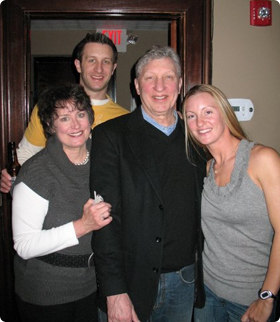Health Hero: Martha Rhodes
Martha Rhodes, a wife and mom of two grown children, had battled depression on and off since she was a teenager. In her 40s, she tried medication to help allay the debilitating symptoms. But the side effects were daunting, and after awhile, the drugs no longer worked for her.

"I had become resistant to the medication," recalls Rhodes, a former advertising executive. "Some people just cannot tolerate the medications. I was one of them."
Feeling increasingly depressed, she began to consume alcohol in greater and greater amounts and mixed in a few prescription medications too. In February 2009, she overdosed on a combination of Xanax® and alcohol.
"I had created the perfect storm for myself," Rhodes recalls. "I cashed in my chips, but fortunately, I have a large family and they rescued me."
Despite two weeks in the hospital and more treatments, she wasn't getting better. Then, Rhodes' sister came across an article about a little-known treatment for depression known as Transcranial Magnetic Stimulation (TMS). Neuronetics NeuroStar TMS therapy, approved in 2008, is the first (and only) therapy of its kind that has been cleared by the U.S. Food and Drug Administration (FDA). While still fairly new, as of June 2012, 418 Neurostars have been installed around the United States, and about 9,000 patients have been treated with TMS.
The non-invasive treatment, which is prescribed by a psychiatrist, uses highly focused, pulsed magnetic fields that stimulate function in particular brain regions. Only tissue that is two to three centimeters into the brain are affected. During a therapy session—which lasts for a little more than half an hour—a magnetic field is administered in short pulses to the front left part of the brain. That area, called the dorsolateral prefrontal cortex, is associated with depression. Initially, the therapy is repeated daily over four to six weeks.
Anthony Barker, MD, invented the first solid-state TMS machine in 1985 in England as he was searching for a way to map the brain areas of stroke patients. As he mapped stroke victims with the technique, the patients started to feel less depressed. Research got underway, and over time, TMS came into use to treat a variety of neuropsychiatric conditions.
After Rhodes was treated with TMS in 2010, the clouds of despair and hopelessness that had taken away her zest for life were lifted. The story of her treatment, and how she got her life back, is chronicled in an about-to-be-published book, 3,000 Pulses. In her book, Rhodes explains how the treatment helped her recover from the severe depression she lived with much of her life.
Each day for six weeks, she went for a TMS treatment. "It takes longer to get a mani-pedi than it does to have a treatment," she said. "I didn't have any headaches, and I didn't feel dizzy or woozy."
As for discomfort, Rhodes said she experienced only mild discomfort and that it stopped after a few treatments. "It felt like my brother giving me a noogie in my head," she said. "It was like a woodpeckering in my head, and after a week, I didn't feel it at all."
After about 20 treatments, Rhodes says, she felt better. "I felt lighter. I started returning phone calls. I wanted to socialize again."
Since the treatments she had in 2010, Rhodes just goes for occasional maintenance. She also makes sure to eat a nutritious diet, get enough rest, and consciously avoid stressful situations. And she finally feels like she's gotten her life back on track. "I have a very normal and full life, thanks to TMS," Rhodes says.

- Stories
- Video
- Top Searches
- 1. Arthritis Management: Nature Heals
- 2. 5 Digestive To-Dos
- 3. Men: Should You Shave It or Leave It?
- 4. Today's Top Fitness Trends
- 5. Sugar and Osteoarthritis : The Link
- 6. Can't Afford Your Hospital Bills?
- 7. Stay Energized All Day Long
- 8. Phobias: Who Has Them and Why?
- 9. What If Your EpiPen Fails?
- 10. 5 Costly Medical Billing Mistakes
- 1. Hotter Temperatures Linked To Kidney Stones
- 2. Summer Bug Bites: What to Look For
- 3. Skin Health Advice with Dr. Kenneth Beer
- 4. Summer Safety Tips That Every Parent Needs To Know
- 5. Sugar and Your Immunity System
- 6. Do Weight Loss Supplements Work?
- 7. 5 Super Foods for Spring
- 8. The Hazards of Reusable Bags
- 9. How to Avoid Ingrown Hairs
- 10. Health Tip: Constantly Change Shoes
- 1. 4 Common Treatments for Epilepsy
- 2. What Does a Urogynecologist Do?
- 3. GERD Without Heartburn? It's Possible
- 4. Graston Technique: Can It Work on You?
- 5. Music Therapy Can Help Autism
- 6. 8 Ways to Fight MS-Related Fatigue
- 7. Can You Still Bleed After Menopause?
- 8. Be Your Own Health Care Advocate
- 9. Why Is Syphillis on the Rise?
- 10. Ideal Weight vs. Happy Weight
|
|  |
|




